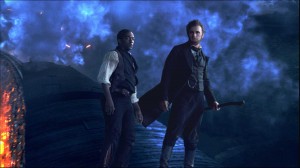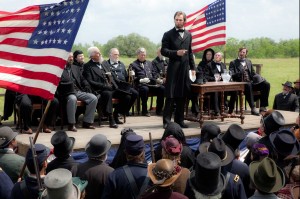
Method Studios recently completed 223 shots on Twentieth Century Fox‘s Abraham Lincoln: Vampire Hunter. The plot explores the secret life of America’s famous president and the untold history of the bloody battle between Lincoln and a horde of evil vampires. Method Studios’ Vancouver team created many complex visual effects sequences for the film including the trestle bridge fire scene, an Abraham Lincoln digital double, digital crowds, a CG Civil War-era train and fully digital environments including the Washington Capitol. The stereo conversion on the film was completed by sister company Stereo D.
Michael Owens served as the production visual effects supervisor. Leading the Method crew were visual effects supervisor Randy Goux and visual effects producer Jinnie Pak.
“I was totally impressed with the Method team,” said Owens. “Randy and Jinnie were very solution-driven, but never without great creative and design suggestions and ideas. The film’s director, Timur Bekmambetov, and the filmmakers were extremely pleased with their work.”
“Timur wanted to see various visual styles from us, which resulted in a very intense look/development phase at the start of this project,” said Goux. “Our main sequence involved the collapse of a burning bridge which also featured Abe Lincoln and Will Johnson involved in hand-to-hand combat with a group of vampires. To make it more complicated, all of this action is happening on top of a moving train at night.”

“The actors were shot on two static box car tops against greenscreen,” Goux explained. “The rest of the surrounding environment and effects were all CG with half of the shots needing to be rendered in stereo while the other half were converted by Stereo D. The director’s filmmaking style included the use of extreme slow motion so we had to develop a flexible system for creating complex volumetric smoke effects. Speed ramps in the action were in constant flux editorially, so at the very least we had to create all of our effects at 250 fps in order to be able to keep up with editorial changes and the fine attention to detail needed for such slow moving effects.”
The fact that this action occurs at night presented specific challenges to the 3D artists and compositors, and believable lighting was of key importance. The CG tree branches and leaves needed to cast moonlit shadows onto the actors and train, and Method also added shadows of the actors into the CG smoke. Not only does the smoke give the sequence a sense of speed, it also adds a great deal of suspense as the vampires appear in and out of the darkness.
“This film was a big technical challenge in terms of the pyro and rigid body destruction effects required, and we developed many new tools to cope with this task,” Sean Lewkiw, Method’s DFX supervisor, added. “One additional aspect of the film that was challenging was producing many of the shots in full stereo which is particularly daunting for semi-transparent elements like fire and smoke. Doing traditional 2D tricks would destroy the stereoscopic effect so we took our time and produced many layers with incredible detail which were expertly composited under the watchful eye of our compositing supervisor Abel Milanes.”





